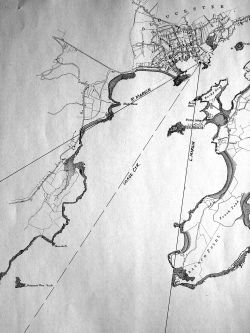loading 
Fitz Henry Lane
HISTORICAL ARCHIVE • CATALOGUE RAISONNÉ • EDUCATIONAL RESOURCE
An online project under the direction of the CAPE ANN MUSEUM
An online project under the direction of the CAPE ANN MUSEUM
Catalog entry
inv. 30
The Old Fort and Ten Pound Island, Gloucester
1850s Oil on canvas 22 x 36 in. (55.9 x 91.4 cm) 33 x 44 in. (frame) No inscription found
|
Related Work in the Catalog
Supplementary Images
Provenance (Information known to date; research ongoing.)
Reverend Jeremiah Healy, Gloucester, Mass.
Addison Gilbert Hospital, Gloucester, Mass., Bequest of Reverend Jeremiah Healy, 1910.
Cape Ann Museum, Gloucester, Mass., December 13, 1978
Exhibition History
No known exhibitions.Published References
Wilmerding, John. Paintings by Fitz Hugh Lane. Washington, DC: National Gallery of Art; in association with Harry N. Abrams, 1988., fig. 10, ill. in b/w, p. 40.
Ronnberg, Erik A.R., Jr. "Views of Fort Point: Fitz Hugh Lane's Images of a Gloucester Landmark." Cape Ann Historical Association Newsletter 26, no. 2–4 (April, July, September 2004)., fig. 3. ⇒ includes  text
text
Wilmerding, John. Fitz Henry Lane. Gloucester, MA: Cape Ann Historical Association, 2005. Reprint of Fitz Hugh Lane, by John Wilmerding. New York: Praeger, 1971. Includes new information regarding the artist's name., ill. 30, text, p. 42.
Craig, James. Fitz H. Lane: An Artist's Voyage through Nineteenth-Century America. Charleston, SC: The History Press, 2006., pl. 18.
Newton, Travers, and Marcia Steele. "The Series Paintings of Fitz Henry Lane: From Field Sketch to Studio Painting." In Emil Bosshard, Paintings Conservator (1945–2006): Essays by Friends and Colleagues, edited by Maria de Peverelli, Mario Grassi, and Hans-Christoph von Imhoff. Florence: Centro Di, 2009, pp. 194–215., fig. 7, p. 204. ⇒ includes  text
text
Lovell, Margaretta. "'Fitz Henry Lane, Spectateur de l'Histoire' ('Watching History—Fitz Henry Lane and the Revolutionary Past in Antebellum New England')." In Refaire L'Amerique: Imaginaire et Histoire des Etats-Unis, Didier Aubert & Helene Quanquin. Paris: Presses Sorbonne Nouvelle, 2011, pp. 47–61., fig. 5, p. 57. ⇒ includes  text
text
Nicholas Robbins. "Rock-Bound: Fitz Henry Lane in 1862." Art Journal (Oxford) Volume 44, no. 1 (2021)., fig. 7, p. 115. ⇒ includes  text
text



Commentary
This painting and its possible color sketch The Old Fort and Ten Pound Island, Gloucester, 1850s (inv. 28) depict Gloucester's Harbor Cove as it looked in the early 1840s. The artist's viewing point was on Duncan Street, on partially filled waterfront which became Fear's Wharf. Rocks were still visible along the shore at low tide. The painting's right margin barely captures the wharf and adjoining bulkhead pier of John W. Lowe. The left margin includes most of Black Rock off the west end of Rocky Neck, Black Bess Rock beyond it, and most distant, the westernmost tip of Eastern Point.
The left-center background depicts Ten Pound Island and its lighthouse; the middle-right far background includes Norman's Woe Rock and Mussel Point. The middle ground, from center to right margin, is dominated by Fort Point, which is connected to the Gloucester mainland by Pavilion Beach (not visible). Atop Fort Point are the remains of Fort Defiance; to its left is a small building identified on some town maps as a bowling alley. Harbor Cove, enclosed by Fort Point and Duncan's Point, provided Gloucester's most important wharfage for merchant and fishing vessels prior to 1865.
For all its importance, Harbor Cove was too shallow and confined for anchoring or berthing large vessels for any purpose but loading and unloading. They were forced to anchor in the Outer Harbor. The most convenient area was called "the Stream"—deep water between Rocky Neck and Duncan's Point and westward, past Ten Pound Island and Fort Point.
The vessels depicted include two pinkies (far left and farthest right), a merchant ship (left background), a packet schooner (center), a merchant sloop (center left), and a sloop-rigged party boat. The pinkies were small schooner-rigged fishing vessels—an obsolete type by 1840, but so well constructed that many lasted through the nineteenth century. Lane might have chosen them to symbolize the midcentury decline in Gloucester's fisheries in favor of the foreign trade, exemplified here by the large merchant ship.
While focused on trade with Surinam, Gloucester's merchants also sent their ships, barks, and brigs to the West Indies, Europe, and India—activity which had peaked by 1850 and ended by 1860. Harbor Cove proved too small and shallow to accommodate the ever-larger vessels, forcing merchants to move their ships and facilities to Boston, or go back to fishing.
The packet schooner and merchant sloop symbolize a constantly busy coastal trade up and down the Atlantic coast, from Canada to the West Indies. The fore-and-aft rigs (sloops and schooners) were best suited to deal with adverse winds while avoiding dangerous shorelines and other hazards to navigation. The better classes of these rigs were packets, sailing on regular schedules between specified ports, carrying mail, passengers, and smaller quantities of merchandise (bulk and high-value) to meet the limited demands of smaller coastal communities.
– Erik Ronnberg